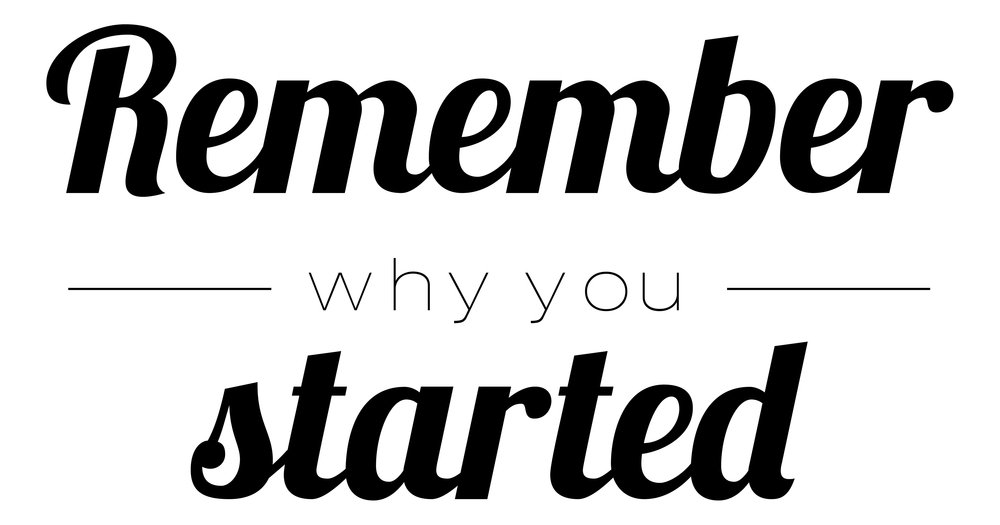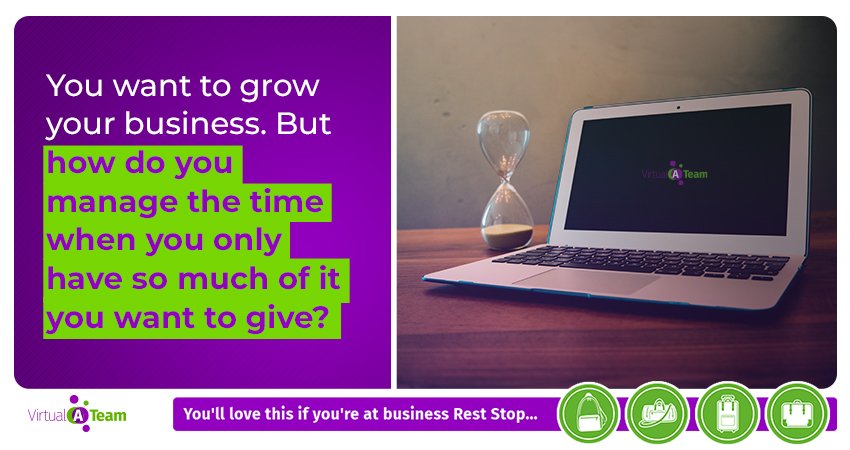You really want to grow your business and be successful. But how do you manage the time when you only have so much of it you want to give?
A few years ago, everyone was talking about this quote from Lori Greiner, one of the investors on the show Shark Tank.
“Entrepreneurs are the only people who will work 80 hours a week to avoid working 40 hours a week”
Unfortunately, it got many entrepreneurs thinking they could only be successful if they worked 80 hours a week! That would mean if you:
- have a full-time job, you can’t be an entrepreneur.
- suffer from chronic health conditions that limit your work time, you can’t be an entrepreneur.
- choose family over business, you can’t be an entrepreneur
The truth is, there are different definitions of success.
For some, it’s having the biggest business around.
For others, success is the perfect work-life balance.
Entrepreneurship isn’t restricted to those that want to work 10 or 12 or 16 hours a day to grow their business.
Rest Stop
If you’re in the early stages of your entrepreneurial journey...rest assured many entrepreneurs successfully grow their businesses in less than 20 hours a week.
Those that are successful with a shortened schedule have a few tricks up their sleeves. And today I want to share some of that magic with you.
Download our Ultimate Guide to Delegating for More Tips & Tools on How to Delegate as a Solopreneur
How to Manage the Time You Have
Those of us with limited hours to work our business, whether by choice or necessity, have a magic secret.
And it’s not that we possess some productivity gene others don’t. But it is rooted in scientific concepts that work in our favor.
The first one is Parkinson’s Law. This concept states that work expands to the time allowed to complete it.

Essentially, that means that more time isn’t going to allow us to do more work.
Instead, we will just take longer to do the same amount of work! That alone should allow us to breathe a sigh of relief knowing we won’t actually be accomplishing more by working more.
Now, let’s talk strategies for managing the time you do have to produce the greatest results.
Vision
Most solopreneurs don’t really think about the vision they want to have for their businesses.
They simply decide on a Tuesday in July that they want to start a business. And by Wednesday afternoon, they are out getting their first clients.
Having a crystal-clear vision for where you want your business to go can be a powerful tool to help you stay focused and manage the time you want to invest in your business.
For example:
- Do you want to have a huge 7-figure business or would you be content with 6 figures?
- Is your goal to create a business that has a social purpose as well?
- Does your dream business involve your lifestyle?
Knowing the answers to these and other vision questions will help you form a vision statement.
We’re not talking lofty ideal vision statement that we frame and hang on the wall like an inspirational poster.
We’re talking about a one-sentence, driving-force kind of statement.

Like when you could go anywhere in the world and you choose an Appalachian Mountain get-away because that’s where your mom always wanted to go on her honeymoon.
It’s about deciding on the destination and knowing why getting there will deeply matter to you.
Pro Tip
Write down the vision you have for your business. What do you want it to look like in 5 years and why? What does THAT particular business get you?
When you have a clear vision, you can make better choices about how to spend and manage the time you have.
And it helps you reject things that will distract you from getting to the Appalachian Mountains.
It’s All in the Planning
A great plan serves as a road map to manage the time you want to work. When you know what to do, you do those things and only those things.
One of the hardest steps successful solopreneurs take is moving from a “fly-by-the-seat-of-my-pants” concept of growing their business to a more structured and planned approach.
This can be a struggle for the creative spirit. We understand! In fact, most of the coaches we work with are very creative and the thought of being limited by a “plan” can be uncomfortable at first.
If you can relate to this, we want to encourage you because the truth of the matter is, it’s not so much about sticking hard and fast to the plan. It’s about the habit of planning.

President Eisenhower confused a lot of people with that quote.
He was saying, plans are not guaranteed. Life happens.
Variables come into play and force constant changes to plans, right?
His underlying message was we have to be flexible. Becoming too rigid can be just as detrimental to success as no planning at all.
And that the magic lies in the planning itself. All the thought and strategy that goes into those plans are what lay the foundation for success.
Think 2020
This year has been a great year to test this theory.
Many plans were set at the beginning of the year. Goals were created, programs were scheduled and plans were made.
And then life happened. The entire world was shut down.
What followed was our need to change plans on an hourly basis some days.

I think we can all agree that to survive quarantine, we had to drop any rigid tendencies we had and employ ongoing flexibility.
It’s been a reminder that even a well-designed plan can change at any given moment.
However, even when you have to add-to, or take-away from, the basic plan framework will still give you a direction to go.
It’s a flight plan
Virtual A Team recently launched our podcast, Coach's CoPilot.
Pilots and CoPilots know that a plane almost never takes a direct flight from point A to point B. Adjustments need to be made along the way of every flight.
But without that flight plan, they would not know what deviations to make in order to stay closely on course.
Pro Tip
Give yourself one day to sit down and plan your business for the next 12 months. Don’t worry about if things change or if COVID has a second wave. Do the planning now. You can refocus as needed depending on circumstances.
Creating a plan is an investment of your time but it’s an investment that will give you significant returns in the long run.
Fractional Analysis
Here’s another scientific principle for you. It’s called the Pareto Principle or the 80/20 rule.

Bear with me, math wasn’t my favorite subject either.
The 80/20 rule suggests that 80% of our results come from 20% of our efforts.
For example, if you are trying to lose weight through diet and exercise, 20% of what you are doing is giving you 80% of the results you are achieving.
What that also means is that 80% of our efforts only gives us a whopping 20% of our results! It’s time to reduce or eliminate that 80%.
The Audit
Lately, many of our clients have requested help with auditing their business.
They want to know what’s working and what’s not.
We review things like their social media and email marketing.
We collect and analyze data from all our client's existing programs.
Are Your Efforts Working?
One of our clients wanted a focused review of her social media efforts.
She posts consistently on Facebook, Pinterest, Instagram, Linkedin, and Twitter.
Every message and many of the graphics are crafted specifically for the channel it is being posted on. Customization is time consuming.
We took a look at how many people she was driving to her website and also how many “conversations” she was having.
It turns out, for this client (and please know your results may differ), Facebook was by far the best use of her time.
That was her 20% driving her 80%.

Linkedin and Twitter produced very little results for her and Pinterest produced results that were actually hurting more than helping.
This coach decided to stop spending time crafting Pinterest images and editing her post length for Twitter. The time she spent on social media went down significantly.
Action Tip: Audit your time and the results you are getting. If it takes you more time than the results deserve, consider letting that task go.

Ditch Flying Solo
Now that you have chosen to be more effective and do the things that move you closer to your goal, it’s time to start thinking about how to also be more efficient.
That means it’s time to stop doing the things that someone else can do and focus on the things that only you can do. It’s time to start delegating.
For coaches who have built their business all on their own, taking on a co-pilot (delegating) is often new territory and scary territory.
There are three keys to making delegation easier for the newbie.
- Make a list of all the tasks you do and begin to decide which ones you can’t or shouldn’t be doing. This is your first task list for your first hire.
- Take your time and hire well. Don’t hire quickly because that’s usually when problems arise.
- Be prepared. When you work with someone else, projects take longer. There’s back and forth communication and different work schedules.
We have a LOT of great articles for the first time delegator. Some of these may be helpful to you.
Embrace Technology
Technology can be super scary if it isn’t in your zone of genius but it can be one of the best time savers we have.
Using technology to automate tasks within your business is often a great investment.
But what are things that you can automate in your business?

Appointment Scheduling
Tools like Calendly or Acuity allow you to create a calendar of available time and let others pick the time that works best for them. These systems even let the scheduler answer a few questions so you know what to expect when you get on the phone (or Zoom).
We’ve reviewed several of the top scheduling tools to help you pick the one that’s right for you.
Social Media Scheduling
You don’t actually have to be available to post to social media at all hours of the day. Tools like SmarterQueue or Buffer allow you to create all of your posts in advance and have them post based on the schedule you choose.
You can even set up posts to go out when you are on vacation!
Pro Tip
Always pay attention to current events that may require you to adjust your posts or schedule. There are times when something you have queued up just won’t come across well after certain events.
We have also reviewed the top social media scheduling tools so you don’t have to!
We often don’t think of automating the emails we receive but there are lots of tools for handling this.
Since Gmail is the largest email service out there, we will focus on that.
Let’s start with some of the features that have been around for a while.
-
See only the emails you want to see when you want to see them.
Gmail’s Rules and Labels feature allows you to set up automations so that emails go to specific “folders” based on their content or who’s sending them. This is great so you never miss a client message or don’t have to see all your store sales emails in the inbox all the time. This feature allows you to stop having to use two different email addresses in order to keep one of them clear of the clutter.
-
Templates used to be called Canned Responses when it was in beta.
This feature allows you to create template text that you send out over and over. If you always find yourself typing the same message, set up some templates to speed up the process.
Pro Tip
Use templates in combination with Rules to send out a template response based on the email that you receive.
-
Customize your signature.
Many of us have Gmail set up to receive multiple different email addresses into one place. Gmail allows you to customize your signature depending on the email being received. You can even rotate your signature if you have a few different PS messages you want to use.
Now let’s talk some of the cool new features Gmail offers.
-
See Ya Later! Gmail’s snooze feature allows you to dismiss an email if you can’t or don’t want to address it at the moment.
It will pop back into your inbox at the top when you want it to. This feature is great if you are clearing your inbox between meetings but don’t have time for lengthy responses.
-
There’s also the option to send your emails at a later date.
This is handy if you happen to be working on the weekends or late at night and don’t want your response to appear as though you work all hours of the day!
If you need help setting up Gmail or any other automations for your business, reach out to Virtual A Team. We’d be happy to lend a hand.
It’s important to remember that automation does not replace humans.
We often get asked about very complex automations and our recommendation is always to evaluate the cost to set up something versus paying a human to do it. How long will it take to break even?

Work Smarter, Not Harder
The best ways to make the most out of the limited time you want or need to work involve working smarter, not harder. More hours will not result in more profit.
To better manage the time you have, focus on these 5 basic principles:
- Have a clear vision.
- Create a plan.
- Find your high reward tasks and focus on those.
- Ditch the solo and delegate.
- Embrace technology and automate.
Realize that this will take an investment of your time. For a short while, you may be working more while you get the tools and systems set up. But the rewards are well worth the investment!
What will you do with all that extra time?
Want more content from this Rest Stop? Check out these articles.
Don't stop now! You'll also love this other great content...


